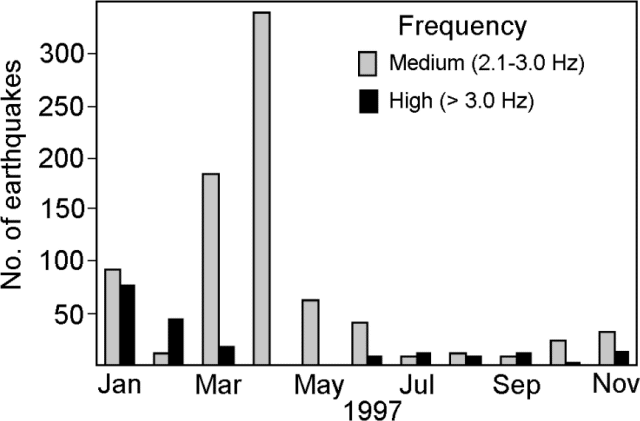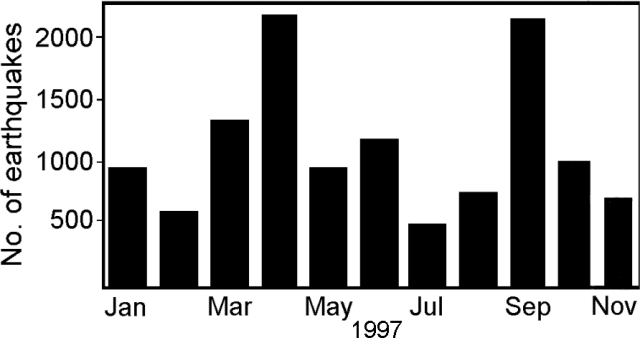Report on Poas (Costa Rica) — November 1997
Bulletin of the Global Volcanism Network, vol. 22, no. 11 (November 1997)
Managing Editor: Richard Wunderman.
Poas (Costa Rica) June-November earthquakes; thermally stable fumaroles
Please cite this report as:
Global Volcanism Program, 1997. Report on Poas (Costa Rica) (Wunderman, R., ed.). Bulletin of the Global Volcanism Network, 22:11. Smithsonian Institution. https://doi.org/10.5479/si.GVP.BGVN199711-345040
Poas
Costa Rica
10.2°N, 84.233°W; summit elev. 2697 m
All times are local (unless otherwise noted)
This report focuses on June-November 1997 but includes histograms of monthly earthquake counts for the period January-November (figures 65 and 66). On these plots, earthquakes are grouped into three frequencies. ... Tremor was absent at Poás during November 1996 through October 1997; during November 1997 tremor prevailed for 22 hours. The previous high was in October 1996 (28 hours).
 |
Figure 66. Monthly counts of medium- and high-frequency earthquakes detected at Poás during January-November 1997. Courtesy of OVSICORI-UNA. |
Compared to its level in May, the lake surface in the northernmost crater rose during June-November. The greenish-turquoise lake's temperatures were as follows: June, 32°C; July, 31°C; September, 35°C; October, 34°C; November, 35°C. Deformation measurements in June disclosed no significant change.
During June-November a fumarole on the N terrace had a temperature of 91-92°C; sulfur was deposited at this fumarole even though gas emissions appeared low. During June-July, and again in October, colorless gas columns were conspicuous above the pyroclastic cone in the crater's center; the columns rose 300 m above the crater floor. Later, during September and November, these columns rose ~400 m. During June-September, escaping steam made a loud noise that was audible from the crater rim; during June-November, at a point where scientists could gain access, the steam's temperature remained at 92-93°C.
Geological Summary. The broad vegetated edifice of Poás, one of the most active volcanoes of Costa Rica, contains three craters along a N-S line. The frequently visited multi-hued summit crater lakes of the basaltic-to-dacitic volcano are easily accessible by vehicle from the nearby capital city of San José. A N-S-trending fissure cutting the complex stratovolcano extends to the lower N flank, where it has produced the Congo stratovolcano and several lake-filled maars. The southernmost of the two summit crater lakes, Botos, last erupted about 7,500 years ago. The more prominent geothermally heated northern lake, Laguna Caliente, is one of the world's most acidic natural lakes, with a pH of near zero. It has been the site of frequent phreatic and phreatomagmatic eruptions since an eruption was reported in 1828. Eruptions often include geyser-like ejections of crater-lake water.
Information Contacts: E. Fernandez, R. Van der Laat, F. de Obaldia, T. Marino, V. Barboza, W. Jimenez, R. Saenz, E. Duarte, M. Martinez, E. Hernandez, and F. Vega, Observatorio Vulcanologico y Sismologico de Costa Rica, Universidad Nacional (OVSICORI-UNA).


